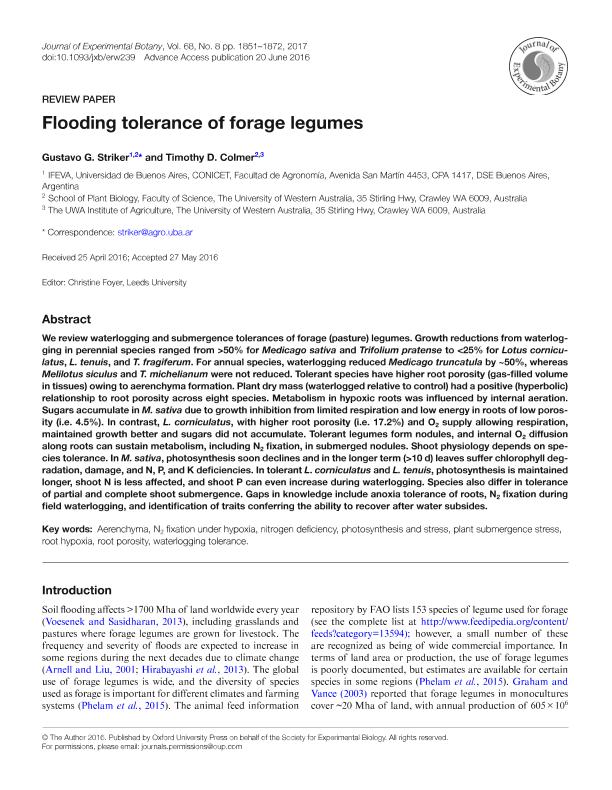Mostrar el registro sencillo del ítem
dc.contributor.author
Striker, Gustavo Gabriel

dc.contributor.author
Colmer, Timothy D.

dc.date.available
2018-08-22T18:15:34Z
dc.date.issued
2017-04
dc.identifier.citation
Striker, Gustavo Gabriel; Colmer, Timothy D.; Flooding tolerance of forage legumes; Oxford University Press; Journal of Experimental Botany; 68; 8; 4-2017; 1851-1872
dc.identifier.issn
0022-0957
dc.identifier.uri
http://hdl.handle.net/11336/56624
dc.description.abstract
We review waterlogging and submergence tolerances of forage (pasture) legumes. Growth reductions from waterlogging in perennial species ranged from >50% for Medicago sativa and Trifolium pratense to <25% for Lotus corniculatus, L. tenuis, and T. fragiferum. For annual species, waterlogging reduced Medicago truncatula by ∼50%, whereas Melilotus siculus and T. michelianum were not reduced. Tolerant species have higher root porosity (gas-flled volume in tissues) owing to aerenchyma formation. Plant dry mass (waterlogged relative to control) had a positive (hyperbolic) relationship to root porosity across eight species. Metabolism in hypoxic roots was influenced by internal aeration. Sugars accumulate in M. sativa due to growth inhibition from limited respiration and low energy in roots of low porosity (i.e. 4.5%). In contrast, L. corniculatus, with higher root porosity (i.e. 17.2%) and O2 supply allowing respiration, maintained growth better and sugars did not accumulate. Tolerant legumes form nodules, and internal O2 diffusion along roots can sustain metabolism, including N2 fxation, in submerged nodules. Shoot physiology depends on species tolerance. In M. sativa, photosynthesis soon declines and in the longer term (>10 d) leaves suffer chlorophyll degradation, damage, and N, P, and K defciencies. In tolerant L. corniculatus and L. tenuis, photosynthesis is maintained longer, shoot N is less affected, and shoot P can even increase during waterlogging. Species also differ in tolerance of partial and complete shoot submergence. Gaps in knowledge include anoxia tolerance of roots, N2 fxation during feld waterlogging, and identifcation of traits conferring the ability to recover after water subsides.
dc.format
application/pdf
dc.language.iso
eng
dc.publisher
Oxford University Press

dc.rights
info:eu-repo/semantics/openAccess
dc.rights.uri
https://creativecommons.org/licenses/by-nc-sa/2.5/ar/
dc.subject
Aerenchyma
dc.subject
N2 Fxation Under Hypoxia
dc.subject
Nitrogen Defciency
dc.subject
Photosynthesis And Stress
dc.subject
Plant Submergence Stress
dc.subject
Root Hypoxia
dc.subject
Root Porosity
dc.subject
Waterlogging Tolerance
dc.subject.classification
Agricultura

dc.subject.classification
Agricultura, Silvicultura y Pesca

dc.subject.classification
CIENCIAS AGRÍCOLAS

dc.title
Flooding tolerance of forage legumes
dc.type
info:eu-repo/semantics/article
dc.type
info:ar-repo/semantics/artículo
dc.type
info:eu-repo/semantics/publishedVersion
dc.date.updated
2018-08-16T15:10:44Z
dc.identifier.eissn
1460-2431
dc.journal.volume
68
dc.journal.number
8
dc.journal.pagination
1851-1872
dc.journal.pais
Reino Unido

dc.journal.ciudad
Oxford
dc.description.fil
Fil: Striker, Gustavo Gabriel. University of Western Australia; Australia. Consejo Nacional de Investigaciones Científicas y Técnicas. Oficina de Coordinación Administrativa Parque Centenario. Instituto de Investigaciones Fisiológicas y Ecológicas Vinculadas a la Agricultura. Universidad de Buenos Aires. Facultad de Agronomía; Argentina
dc.description.fil
Fil: Colmer, Timothy D.. University of Western Australia; Australia
dc.journal.title
Journal of Experimental Botany

dc.relation.alternativeid
info:eu-repo/semantics/altIdentifier/url/https://academic.oup.com/jxb/article/68/8/1851/2628936
dc.relation.alternativeid
info:eu-repo/semantics/altIdentifier/doi/http://dx.doi.org/10.1093/jxb/erw239
Archivos asociados
